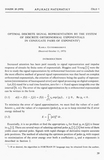Article
Full entry |
 PDF
(1.4 MB)
Feedback
PDF
(1.4 MB)
Feedback
 PDF
(1.4 MB)
Feedback
PDF
(1.4 MB)
Feedback
Summary:
The paper deals with optimal discrete signal representation by the system of discrete orthonormal exponentials with conjugate pairs of exponents on digital computer. The necessary condition of approximation error minimization of the energy approximation both over $n$ coefficients and $n$ exponents leads to a system of $2n$ equations which are nonlinear in exponents. The equivalent condition is found by means of interpretation in the abstract vector space which, however, requires solutions of the system of nonlinear algebraic equations. A linear iterative method is proposed for solution of the described equation system. Examples illustrating the theoretical conclusions of the method described are presented.
The method provides a minimum number of parameters characteristic of the signal given while preserving the required accuracy of signal approximation, on the one hand, and is suitable for use for empiric discrete signals not known analytically, on the other.
References:
[1] Young T. Y., Huggins W. H.: On the Representation of Electrocardiograms. IEEE Transactions on Bio-Medical Electronics BME-10, July 1963, 86-95.
[2] Young T. Y., Huggins W. H.: Discrete Orthonormal Exponential. Proc. of National electronics Conf. vol. 18, October 1962, 1 - 9.
[3] Kautz W. H.: Transient Synthesis in the Time Domain. IRE Transaction-Circuit Theory, vol. CT-1, September 1954, 29-39.
[4] Young T. Y.: Complementary Signals and Orthogonalized Exponentials. IRE Trans. CI-9, December 1962, 362-370.
[5] Guttenbergerová K.: Dissertation FEL ČVUT Praha 1972.

